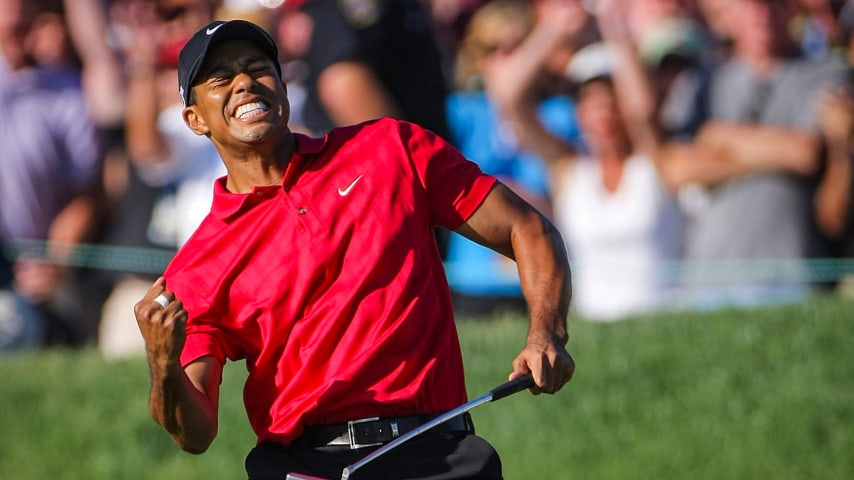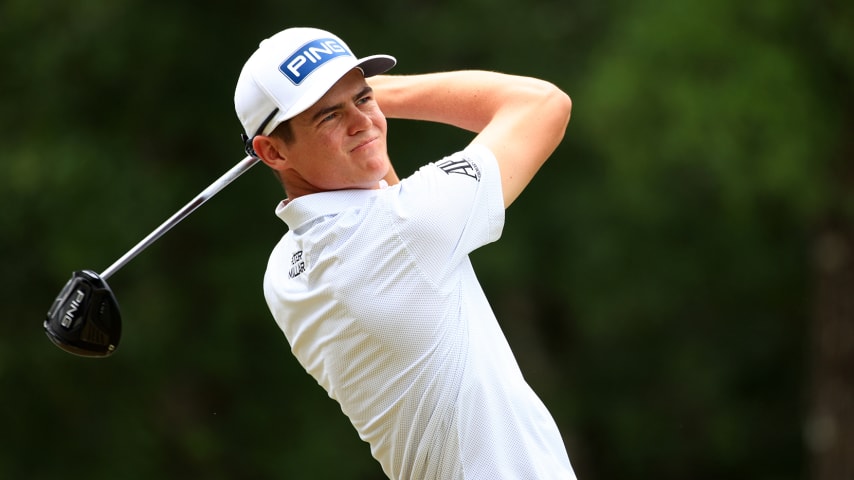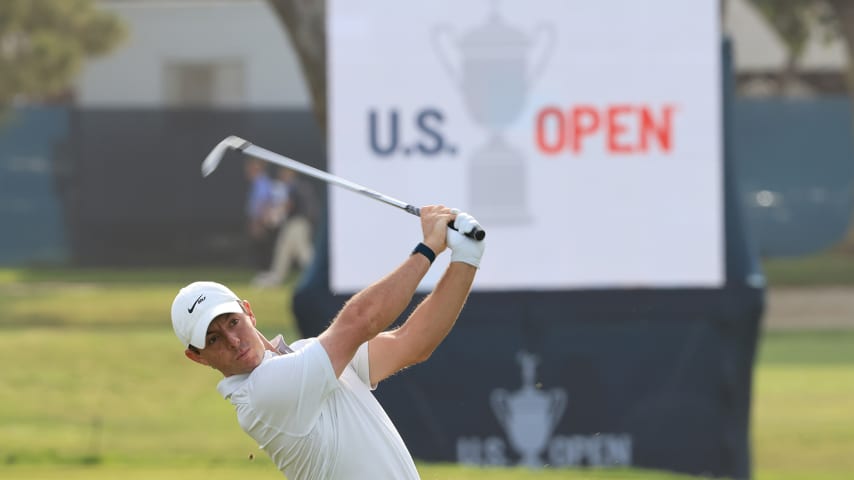A statistical deep dive on Tiger’s win at the 2008 U.S. Open
6 Min Read

Written by Justin Ray,

Tiger Woods’ best approaches into par 5s
This week, the U.S. Open returns to Torrey Pines, site of one of golf’s most memorable major championship showdowns.
The on-course heroics of Tiger Woods that week in 2008 are forever ingrained in the minds of golf fans worldwide. Perhaps the bigger surprise came from Rocco Mediate, an unlikely foil who took Woods to the absolute limit that week in California. Thirteen years later, the story is no less enthralling, no less remarkable, than it was in real time.
Untouchable Tiger
In order to best paint the picture of this David and Goliath matchup, you have to fully appreciate how dominant Woods was at this point in his career. Tiger wasn’t just the No. 1 player in the world, he was the unquestioned relentless force in the sport for a decade running. After a runner-up finish at the 2008 Masters, Woods had an Official World Golf Ranking points average of 21.19. Phil Mickelson was second, at 9.62. This meant that there was a larger gap between Woods and Mickelson (11.57 average points) than Phil and the bottom of the Ranking.
Woods entered the week having won five of his previous 13 major starts. In his professional career, he had played in 45 majors, winning 13 of them – an absurd 29% clip. From 1997 through the 2008 Masters, there were 111 players with 50 or more rounds in major championships. Woods, at 125 under par in that span, was 198 shots better in relation to par than any other player (Ernie Els, +73). In fact, Els and Phil Mickelson (+74) were the only players within 200 shots of Woods in relation to par during that span in majors.
Despite his knee injury, Woods was playing some of the most dominant golf of his entire illustrious career. Entering the 2008 U.S. Open, Woods had played in 11 tournaments worldwide since August of the previous year. He won eight times, with three of his victories being by eight strokes or more. He didn’t finish worse than fifth and posted a scoring average of 67.6 in that span.
During that run of eleven tournaments, the combined total of opponents in those fields was 1,227. Woods was beat by six of them.
Now consider how dominant Woods had been at Torrey Pines. In 11 starts at the Farmers Insurance Open from 1998 through 2008, Woods had won six times and never finished worse than tied for tenth. Woods was a combined 158 under par at the event during that stretch, 85 strokes better than any other player in that span (Mickelson was second, at 73 under). Only two players were within 100 shots of Woods in relation to par at Torrey Pines in those eleven combined tournaments. Woods won all five tournaments he played at Torrey Pines from 2005-08.
Definition of an Underdog
Rocco Mediate was 158th in the Official World Golf Ranking the week of the 2008 U.S. Open. At 45 years old, he was more than six years removed from his previous PGA TOUR win, in April of 2002. Woods had won 33 times on TOUR – including each of the four major championships (six majors in all) - since Mediate’s last victory.
Mediate had missed the cut at Torrey Pines earlier that year in his first start there in a decade, one of seven missed cuts in his first nine starts that season. To that point in his career, Woods had missed just four cuts as a professional on the PGA TOUR. It had been six years since Mediate finished a PGA TOUR season ranked inside the top 40 in scoring average.
Mediate had, however, come off his best finish of the season, a tie for sixth at the Memorial Tournament. He ranked fifth in the field that week in Strokes Gained: Tee-to-Green and 11th in Strokes Gained: Approach, both high-water marks for his 2008 campaign to date. Mediate had found some previous success in the U.S. Open, finishing fourth in 2001 and tied for sixth in 2005.
Statistical Profiles that Week
Over the years, Torrey Pines has been kind to players who are a little wild off the tee. Over the last forty years, more PGA TOUR winners at the venue have ranked outside the top-50 that week in driving accuracy (15) than inside the top-10 (seven). Woods was part of that wilder group: at the 2008 U.S. Open, he hit just 54% of the fairways for the week, ranking tied for 56th in the field. Nobody would hit fewer fairways on their path to a U.S. Open victory until Bryson DeChambeau did in 2020 at Winged Foot (41.1%).
Woods was rewarded, however, for hitting some more accurate tee shots on par-5s. On the twelve par five holes Woods played in regulation, he hit the fairway with his tee shot nine times. In turn, he led the tournament in par-5 scoring average, carding three eagles and four birdies on Nos. 9, 13 and 18.
For the week, Mediate was outdriven by Woods on average by 37.5 yards. Still, he led the field in par four scoring average (4.0), par-4 birdie-or-better percentage (22.7%) and front-nine scoring (34.3). While the field scrambled at a clip of just 44.4% for the tournament, Mediate got up-and-down 61.5% of the time, the fifth-best rate of any player. His greenside magic helped him avoid the big number, as he made only one double bogey through 72 holes.
The Playoff
As Woods took a three-shot lead through 10 holes, it looked as if Mediate’s dream run had come to an end. But Rocco rallied, making three consecutive birdies on the back nine to take a one-stroke lead. In regulation, only two players had birdie streaks all week longer than what Mediate put together in that do-or-die situation against Woods. For the second day in a row, Tiger needed to birdie the 18th hole to force a playoff with Mediate.
Of course, he did, and would win with par on the first hole of sudden death. The win was his 14th professional major, getting there more than three years younger than Jack Nicklaus was when he won his 14th, the 1975 PGA Championship. Woods remained perfect (14-for-14) when holding the 54-hole lead or co-lead in a major championship, a streak that ended at the following year’s PGA.
Had Mediate won, he would have shattered the record for lowest world ranking by a U.S. Open champion, at 158th. To this day, that mark is held by Steve Jones, who was ranked 99th in the OWGR when he won in 1996. In the twelve U.S. Opens since, none have been decided by playoff, the longest streak without one in this championship’s history.





